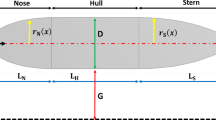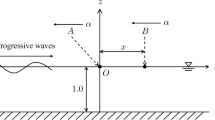Abstract
This paper presents laboratory experiments and numerical simulations of effects of submerged obstacles on tsunami-like solitary wave and its run-up. This study was carried out for the breaking and non-breaking solitary waves on 1:19.85 uniform slope which contains a submerged obstacle. New laboratory experiments are performed to describe the mitigation of tsunami amplitude and run-up under the effect of submerged obstacles. We are based on experimental results obtained to validate the numerical model. The numerical modeling using COULWAVE aims essentially to show the effect of the obstacle on the shape of solitary wave and the limit of this effect. Using a multiple nonlinear regression, we have determined a model to estimate height of run-up according to the amplitude of the wave and the obstacle peak depth.











Similar content being viewed by others
References
Belega D (2013) Accuracy analysis of the normalized frequency estimation of a discrete-time sine-wave by the average-based interpolated DFT method. Measurement 46(1):593–602
Briggs M, Synolakis C, Harkins D (1995) Tsunami run-up on conical island. In: Isaacson M, Quick M (eds) Proceedings of the wave-physical and numerical modeling. University of British Columbia, Vancouver, pp 446–455
Brocchini M, Gentile R (2001) Modeling the run-up of significant wave groups. Cont Shelf Res 21:1533–1550
Carrier G, Greenspan H (1958) Water waves of finite amplitude on a sloping beach. J Fluid Mech 4:97–109
Carrier G, Wu T, Yeh H (2003) Tsunami run-up and draw-down on plane beach. J Fluid Mech 475:79–99
Chang K, Hsu T, Liu P (2001) Vortex generation and evolution in water waves propagating over a submerged rectangular obstacle: part I. Solitary waves. Coast Eng 44:13–36
Chang Y, Hwang K, Hwung H (2009) Large-scale laboratory measurements of solitary wave inundation on a 1:20 slope. Coast Eng 56:1022–1034
Didenkulova I, Zahibo N, Kurkin A, Levin B, Pelinovsky E, Soomere T (2006) Run-up of nonlinearly deformed waves on a coast. Dokl Earth Sci 411:1241–1243
Didenkulova I, Pelinovsky E, Soomere T, Zahibo N (2007) Runup of nonlinear asymmetric waves on a plane beach. In: Kundu A (ed) Tsunami and nonlinear waves. Springer, Berlin, pp 175–190
Didenkulova I, Pelinovsky E, Soomere T (2009) Runup characteristics of symmetrical solitary tsunami waves of “unknown” shapes. Birkhäuser, Basel, pp 2249–2264. doi:10.1007/978-3-0346-0057-6_13
Geist EL, Lynett PJ, Chaytor JD (2009) Hydrodynamic modeling of tsunamis from the Currituck landslide. Mar Geol 264(12):41–52. doi:10.1016/j.margeo.2008.09.005 (Tsunami hazard along the U.S. Atlantic coast)
Goring D, Raichlen F (1980) The generation of long waves in the laboratory. In: Edge Billy L (ed) Seventeenth coastal engineering conference. American Society of Civil Engineers, Sydney, pp 763–783
Hsiao SC, Lin TC (2010) Tsunami-like solitary waves impinging and overtopping an impermeable seawall: experiment and RANS modeling. Coast Eng 57(1):1–18
Hsiao SC, Hsu TW, Lin TC, Chang YH (2008) On the evolution and run-up of breaking solitary waves on a mild sloping beach. Coast Eng 55(12):975–988
Jianhong Y, Dongsheng J, Ren W, Changqi Z (2013) Numerical study of the stability of breakwater built on a sloped porous seabed under tsunami loading. Appl Math Model 37(23):9575–9590
Kaistrenko V, Mazova R, Pelinovsky E, Simonov K (1991) Analytical theory for tsunami runup on a smooth slope. Int J Tsunami Soc 9:115–127
Knouglou U (2004) Nonlinear evolution and run-up-rundown of long over a sloping beach. J Fluid Mech 513:363–372
Knouglou U, Synolakis C (2006) Initial value problem solution of nonlinear shallow water-wave equations. Phys Rev Lett 97:481–501
Lan Y, Lee J (2010) On waves propagating over a submerged poro-elastic structure. Ocean Eng 37:705–717
Lee J, Lan Y (1996) A second-order solution of waves passing porous structures. Ocean Eng 23:143–165
Li Y, Raichlen F (2003) Energy balance model for breaking solitary wave runup. J Waterw Port Coast Ocean Eng 129(2):47–59
Lin P (2004) A numerical study of solitary wave interaction with rectangular obstacles. Coast Eng 51:35–51
Lin P, Chang K, Liu P (1999) Runup and rundown of solitary waves on sloping beaches. J Waterw Port Coast Ocean Eng 125(5):247–255
Lin C, Ho T, Chang S, Hsieh S, Chang K (2005) Vortex shedding induced by a solitary wave propagating over a submerged vertical plate. Int J Heat Fluid Flow 26:894–904
Liu P, Cheng Y (2001) A numerical study of the evolution of solitary over a shelf. Phys Fluids 13(6):1660–1667
Liu P, Al-banaa K (2004) Solitary wave run-up and force on a vertical barrier, numerical modelling of wave interaction with porous structures. J Fluid Mech 505:225–233
Liu P, Synolakis C, Yeh H (1991) Tsunami in Papua New Guinea was intense as first thought. J Fluid Mech 229:675–688
Losada M, Vidal C, Medina R (1989) Experimental study of the evolution of a solitary wave at an abrupt junction. J Geophys Res 94(C10):14557–14566
Lynett P (2006) Nearshore modeling using high-order Boussinesq equations. J Waterw Port Coast Ocean Eng 132(5):348–357
Lynett P, Liu P (2002) A two-dimensional, depth-integrated model for internal wave propagation over variable bathymetry. Wave Motion 36:221–240
Lynett P, Liu P (2005) A numerical study of the runup generated by threedimensional landslides. J Geophys Res Oceans 110(C3):C03006. doi:10.1029/2004JC002443
Lynett P, Wu T, Liu P (2002) Modeling wave runup with depth-integrated equations. Coast Eng 46:89–107
Madsen P, Fuhrman D (2008) Run-up of tsunamis and long waves in terms of surf-similarity. Coast Eng 55:209–223
Mazova R, Osipenko N, Pelinovsky E (1991) Solitary wave climbing a beach without breaking. Rozpr Hydrotech 54:71–80
Pedersen G (2008) Modeling runup with depth integrated equation models. In: Liu Philip L-F, Harry Y, Costas S (eds) Advanced numerical models for simulating tsunami waves and runup, vol 10. pp 3–42
Padersen G, Gjevik B (1983) Run-up of solitary waves. J Fluid Mech 142:283–299
Pelinovsky E, Mazova R (1992) Exact analytical solutions of nonlinear problems of tsunami wave run-up on slopes with different profiles. Nat Hazards 6:13–17
Ramsden J (1996) Forces on a vertical wall due to long waves, bores, and dry-bed surges. J Waterw Port Coast Ocean Eng 122(3):134–141
Synolakis CE (1987) The runup of solitary waves. J Fluid Mech 185:523–545. doi:10.1017/S002211208700329X
Synolakis CE (1991) Tsunami runup on steep slopes: how good linear theory really is. Nat Hazards 4(2–3):221–234. doi:10.1007/BF00162789
Synolakis CE, Bernard E (2006) Tsunami science before and after 2004. Philos Trans R Soc A 364:2231–2265. doi:10.1098/rsta.2006.1824
Tadepalli S, Synolakis C (1994) The run-up of n-waves. Proc R Soc Lond A 445:99–112
Tinti S, Tonini R (2005) Analytical evolution of tsunamis induced by near-shore earthquakes on a constant-slope ocean. J Fluid Mech 535:33–64
Tsung WS, Hsiao SC, Lin TC (2012) Numerical simulation of solitary wave run-up and overtopping using Boussinesq-type model. J Hydrodyn Ser B 24(6):899–913
Wu YT, Hsiao SC, Huang ZC, Hwang KS (2012) Propagation of solitary waves over a bottom-mounted barrier. Coast Eng 62:31–47. doi:10.1016/j.coastaleng.2012.01.002
Wu YT, Yeh CL, Hsiao SC (2014) Three-dimensional numerical simulation on the interaction of solitary waves and porous breakwaters. Coast Eng 85:12–29
Xiao H, Huang W (2008) Numerical modeling of wave runup and forces on an idealized beachfront house. Ocean Eng 35:106–116
Acknowledgements
This work was partly supported by the laboratory LEGHYD-USTHB, Algiers. The anonymous reviewers are, also, thanked for their helpful comments.
Author information
Authors and Affiliations
Corresponding author
Rights and permissions
About this article
Cite this article
Touhami, H.E., Khellaf, M.C. Laboratory study on effects of submerged obstacles on tsunami wave and run-up. Nat Hazards 87, 757–771 (2017). https://doi.org/10.1007/s11069-017-2791-9
Received:
Accepted:
Published:
Issue Date:
DOI: https://doi.org/10.1007/s11069-017-2791-9




